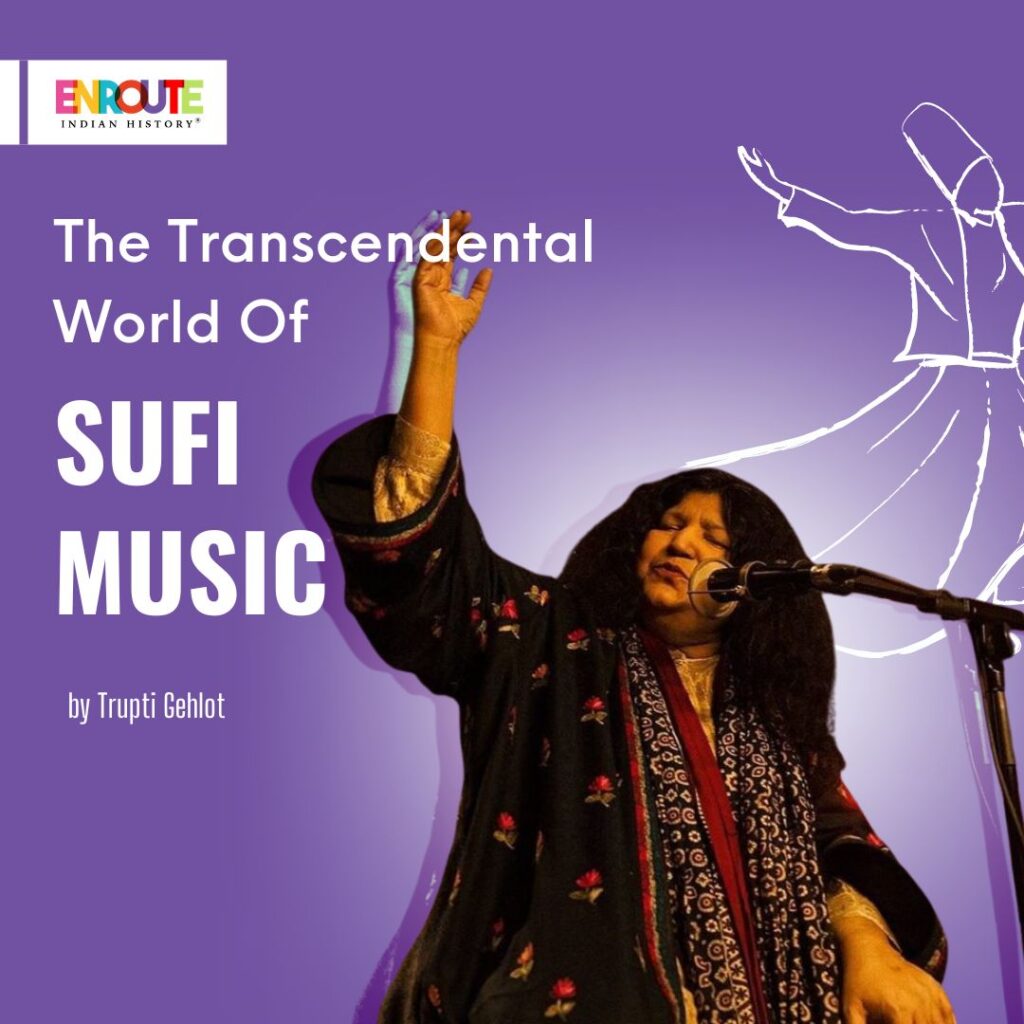
Article Written By EIH Researcher And Writer
Trupti Gehlot
“Kun Faya Kun” – the soul-stirring rendition of a Sufi song, often reminds us of how deeply interwoven Sufi musical legacy is with our day-to-day beats. Sufi music is interpreted as qawwali in the Indian subcontinent. The origin of Sufi music itself can be traced back to the 13th century in Persia and is a tribute to the adored saints and a hymn to the holy. For centuries, Sufi music and qawwali have been interwoven into the fabric of Oriental culture. The Sufis, a group from Islam, saw religion as “love for God”. The Sufis used music and dance to form direct communion with God.
The Sufi philosophy of music includes Dzikr-e-khafi (recitation within one’s heart or with no sound) and Dzikr-e-jali (loud recitation). The three pillars of Sufi music are zaman (the path), maqam (the goal, or proximity to Allah), and riqwan (the act of practising and dedicating oneself). Under a Pir/Khwaja, the Sufis were divided into various silsilas, with the Khanqah as the activity hub. Sufis organised samas to produce mystical ecstasy in adoration of their Pir/Khwaja. In India, the Chishti silsilah or order of Sufi music and practice predominates. Persian and Urdu texts authored by Chishti authors used the term Sama (listening) and presently, this kind of music is commonly referred to as qawwali.
Qawwali, a captivating and significant form of musical expression rooted in the spiritual and devotional core of Sufism, contains profound poetry lines and heart-stirring melodies. The Chishti silsilah, which was founded by Mouinuddin Chishti in India, is the most predominant. Sheikh Hamiduddin of Nagaur and Qutubuddin Bakhtiyar Kaki were the disciples of Khwaja Chisti. Later on, their disciples popularised the Chishti Silsilah and Hazrat Nizamuddin Auliya and Amir Khusrau were instrumental in popularising and defining qawwali as a unique musical genre. The essential principles of qawwali are derived from the mystical Sufi teachings and their poetic manifestations. Amir Khusrau is also called the cultural mediator fusing the Persian and Indian musical traditions to create Qawwali. You might have heard the famous song ‘Chap Tilak’, which was a poem/ghazal written by Amir Khusrau in the 14th century and is now widely sung during qawwali gatherings.
Qawwali is mostly performed in “Mehfils” or “Sama” gatherings where musicians and audience members come together to achieve spiritual ecstasy. With his beautiful voice, the main singer referred to as the “qawwal” guides the group with the assistance of supporting vocalists and musicians who play the harmonium, tabla, sarangi, and dholak. By clapping along with the chanting and actively participating, the audience fosters a sense of divine harmony. Long stretches of Sargam improvisation may be performed by some singers, particularly when they alternate improvisations with a student singer. Themes of divine love, unity, and the pursuit of spiritual enlightenment are central to the lyrics, frequently written in Urdu or Persian. Qawwali is a lively expression of the poetry of prominent Sufi poets like Rumi, Hafiz, and Bulleh Shah. The transcendental experience that qawwali poetry offers binds a thread that forms communion with the divine.
When discussing their experiences at qawwali sessions, regular participants frequently refer to travel. They feel like they are travelling to another domain or plane, called hal, literally ‘state of mind’. The last stage of hal is fana, the closest analogue of which is the Buddhist concept of nirvana. Occasionally, cases of deaths during qawwali sessions are reported and are believed to lead to Fana, and Saint Hazrat Qutubuddin Bakhtiar Kaki reportedly died in a qawwali-induced trance in 1236. Whether it’s a myth or a reality, a qawwali gathering does produce an indescribable force.
Various resources provide the idea that women were often excluded from such gatherings. According to Eaton (2000, pp. 190–191), the bulk of folk poetry written by the Sufis of Deccan was sung by village women while engaged in various household chores like charkha-nama (while spinning cotton) and chakki-nama. Even still, except for the introduction of personalities like Abida Parveen, who likewise did not perform in the traditional style, the qawwali meetings continued to be dominated by men.
Many studies also outline an interface between Hindustani music and Sufism. They suggest that during the rule of the Delhi Sultanate as well as The Mughals, there was an enormous interchange of cultural aspects, which included new forms of musical synthesis like qawwali and khyal in addition to tappa, Tarana, and thumri. In this regard also the name of Amir Khusrau outshines, who was fluent in Persian as well as Braj Bhasha and contributed greatly to Hindustani music.
Numerous gifted qawwali performers have graced the stage throughout the ages, leaving a lasting impression on Indian music history. Legends like Nusrat Fateh Ali Khan, trained in the Chishti qawwali ritual, Sabri Brothers, Aziz Mian, and Abida Parveen are lauded for their extraordinary vocal prowess and capacity to elicit powerful emotions from the audience. The qawwali tradition has been preserved and spread because of their contributions. This genre also found its way into Hindi films in 1960 through ‘Yeh Ishq Ishq hai’, creating a whole new subgenre called filmi qawwali.
Despite having roots in ancient customs, qawwali is still a thriving art form today. Contemporary qawwali music has been influenced by performers like Rahat Fateh Ali Khan, A.R. Rahman, and the Wadali Brothers. Since then, the trends have changed, and Sufi music festivals and events are being organised. Sufi music has expanded into new subgenres like Sufi rock and techno sufi, all of which are incredibly popular, but we have to remember that Sufi music is fundamentally much more than that. Sufi music is fundamentally revered in terms of culture and spirituality, as are other religious practices in India which are deeply embedded and transcend the varied differences.
References
Anuradha Bhattacharjee and Shadab Alam The Origin and Journey of Qawwali, Journal of Creative Communications, 7, 3 (2012)
Shaheer Ellahi Khan, Abid Ghafoor Chaudhry, Haris Farooq, Aftab Ahmed REVIEWING QAWWALI: ORIGIN, EVOLUTION AND ITS DIMENSIONS 2015




















